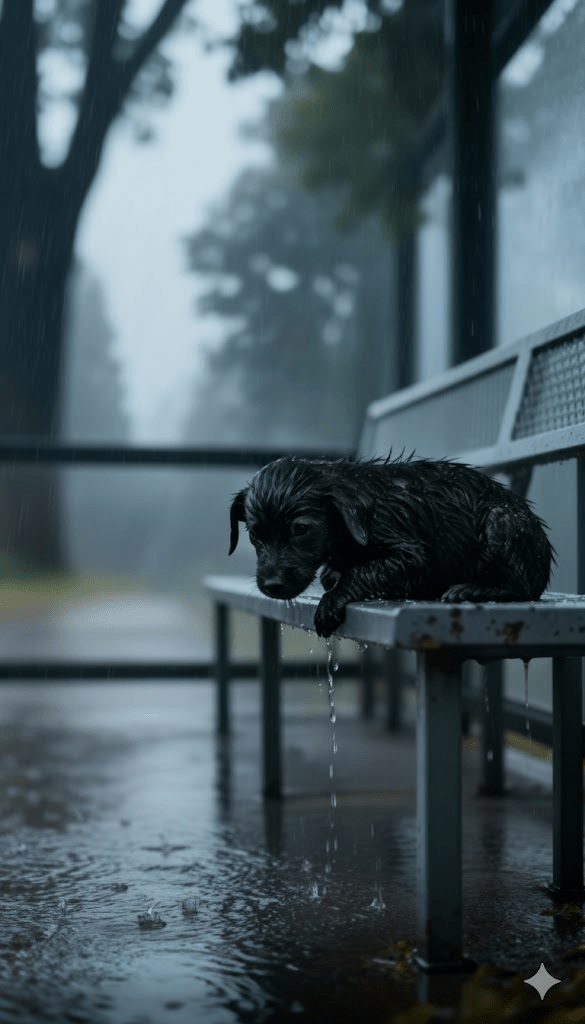The persistent patter of rain against cold metal, the dreary grey of a forgotten park, and the solitary figure of a small, wet puppy perched precariously on a weathered bench – this poignant scene encapsulates a reality far too common, yet often overlooked. It’s a snapshot that tugs at the heartstrings, prompting questions about the circumstances that led to this creature’s isolation and the untold stories of countless others like it. This image, stark in its simplicity, serves as a powerful reminder of the vulnerability of stray animals and the profound impact of human choices on their lives. It invites us to look beyond the immediate emotion and delve into the deeper societal issues surrounding pet abandonment, the challenges faced by these resilient survivors, and the collective responsibility we share in creating a more compassionate world for all living beings. The puppy’s downcast gaze and shivering posture speak volumes, conveying a sense of despair and helplessness that transcends the boundaries of species, urging us to acknowledge the unseen struggles that unfold in the shadows of our bustling lives.

The harsh reality for many stray animals is a constant battle against the elements. Rain, as depicted in the opening image, is more than just an inconvenience; it can be a life-threatening ordeal for an animal without shelter. Hypothermia is a grave danger, especially for young or elderly animals, or those with compromised health. Their fur, designed to provide insulation, becomes saturated and heavy, draining their body heat at an alarming rate. Beyond the immediate threat of cold, heavy rainfall can lead to flash flooding, washing away safe resting places and sources of food, further disorienting an already vulnerable creature. The constant exposure to harsh weather conditions not only affects their physical well-being but also takes a significant toll on their mental and emotional state, leaving them perpetually anxious and stressed.

Hunger and thirst are ever-present companions for animals living on the streets. Unlike domesticated pets with regular meals and access to fresh water, strays must constantly forage for sustenance, often consuming scraps that are spoiled, contaminated, or entirely indigestible. This leads to a myriad of health issues, including malnutrition, parasitic infections, and digestive problems. Water sources can be equally scarce and dangerous, with animals forced to drink from puddles or contaminated run-off, increasing their susceptibility to waterborne diseases. The constant search for food and water consumes a significant portion of their limited energy, leaving them exhausted and even more susceptible to illness and injury.

Stray animals also face significant threats from human interaction, both accidental and intentional. Traffic accidents are a leading cause of injury and death for animals on the streets, as they navigate busy roads without the understanding or protection afforded to pedestrians. Furthermore, some individuals harbor prejudice or fear towards stray animals, leading to acts of cruelty, neglect, or even outright violence. These encounters, often traumatic, can leave deep psychological scars, making it even more challenging for these animals to trust humans in the future.

Medical issues, left untreated, can quickly escalate for stray animals. Wounds from fights with other animals, injuries from accidents, and chronic conditions like skin infections, dental problems, and parasites go largely unaddressed. Without access to veterinary care, minor ailments can become life-threatening, causing immense suffering and often leading to premature death. The absence of routine vaccinations also leaves them vulnerable to highly contagious and often fatal diseases, which can spread rapidly through stray populations.

One of the most heart-wrenching aspects of the stray animal crisis is the loss of companionship and affection. These animals, regardless of their past, often crave interaction and comfort, yet they are forced to endure a solitary existence. The psychological impact of abandonment and isolation can be profound, leading to fear, anxiety, and depression. The absence of a loving home denies them the emotional security and positive human connection that is vital for their well-being, leaving them to navigate a harsh world alone.







